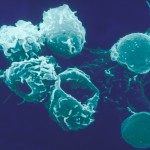Link to Pubmed [PMID] – 15146297
Immunogenetics 2004 Jun;56(3):204-13
Nontemplate (N)-nucleotide addition by the terminal dideoxynucleotidyl transferase (TdT) at the junctions of rearranging V( D) J gene segments greatly contribute to antigen-receptor diversity. TdT has been identified in several vertebrate species, where it is highly conserved. We report here the isolation of two forms of TdT mRNA in an amphibian, the Mexican axolotl. The isoform TdT1 shares all of the conserved structural motifs required for TdT activity and displays an average of 50-58% similarity at the amino acid level with TdT of other species. The second axolotl TdT variant ( TdT2) differs from TdT1 by a 57-amino acid deletion located between amino acids 165-222 of TdT1, including the first helix-hairpin-helix DNA-binding motif. During ontogeny, TdT products are first detected in the head of 6-week-old larvae and further in the head and trunk of 8-month-old larvae. These developmental stages correspond to the first detection of RAG1 and antigen-receptor (TCRbeta and IgHmicro) products in axolotl larvae. Our results suggest that in contrast to mammalian development, N diversity occurs early in axolotl development to diversify the primary repertoire. Phylogenetic analyses reveal that TdT and DNA polymerase mu(Pol mu) genes are closely related, and that both enzymes were already present in the common ancestor of jawed vertebrates.

